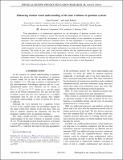Files in this item
Enhancing student visual understanding of the time evolution of quantum systems
Item metadata
| dc.contributor.author | Passante, Gina | |
| dc.contributor.author | Kohnle, Antje | |
| dc.date.accessioned | 2019-02-28T16:56:49Z | |
| dc.date.available | 2019-02-28T16:56:49Z | |
| dc.date.issued | 2019-02-13 | |
| dc.identifier | 257965224 | |
| dc.identifier | 0d414a93-715c-44a1-9605-7704f395dc84 | |
| dc.identifier | 000458825700001 | |
| dc.identifier | 000458825700001 | |
| dc.identifier | 85066406363 | |
| dc.identifier.citation | Passante , G & Kohnle , A 2019 , ' Enhancing student visual understanding of the time evolution of quantum systems ' , Physical Review Physics Education Research , vol. 15 , no. 1 , 010110 . https://doi.org/10.1103/PhysRevPhysEducRes.15.010110 | en |
| dc.identifier.issn | 2469-9896 | |
| dc.identifier.other | ORCID: /0000-0003-2638-4826/work/54818732 | |
| dc.identifier.uri | https://hdl.handle.net/10023/17171 | |
| dc.description | Authors thank the University of St Andrews for funding the development of simulations. | en |
| dc.description.abstract | Time dependence is of fundamental importance for the description of quantum systems, but is particularly difficult for students to master. We describe the development and evaluation of a combined simulation-tutorial to support the development of visual understanding of time dependence in quantum mechanics. The associated interactive simulation shows the time dependence of an energy eigenstate and a superposition state, and how the time dependence of the probability density arises from that of the wave function. In order to assess transitions in student thinking, we developed a framework to characterize student responses in terms of real and complex mathematical reasoning and classical and quantum visual reasoning. The results of pre-, mid-, and post-tests indicate that the simulation-tutorial supports the development of visual understanding of time dependence, and that visual reasoning is correlated with improved student performance on a question relating to the time evolution of the wave function and the probability density. The results also indicate that the analogy of a classical standing wave for the infinite well energy eigenfunctions may be problematic in cueing incorrect ideas of time dependence. | |
| dc.format.extent | 14 | |
| dc.format.extent | 1035861 | |
| dc.language.iso | eng | |
| dc.relation.ispartof | Physical Review Physics Education Research | en |
| dc.subject | Conceptual framework | en |
| dc.subject | Mechanics | en |
| dc.subject | Simulations | en |
| dc.subject | LB2300 Higher Education | en |
| dc.subject | QC Physics | en |
| dc.subject | NDAS | en |
| dc.subject.lcc | LB2300 | en |
| dc.subject.lcc | QC | en |
| dc.title | Enhancing student visual understanding of the time evolution of quantum systems | en |
| dc.type | Journal article | en |
| dc.contributor.institution | University of St Andrews. School of Physics and Astronomy | en |
| dc.contributor.institution | University of St Andrews. Centre for Higher Education Research | en |
| dc.identifier.doi | 10.1103/PhysRevPhysEducRes.15.010110 | |
| dc.description.status | Peer reviewed | en |
This item appears in the following Collection(s)
Items in the St Andrews Research Repository are protected by copyright, with all rights reserved, unless otherwise indicated.

